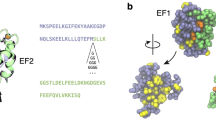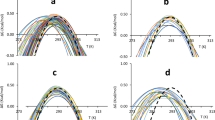Abstract
The protein engineering analysis of the α-spectrin SH3 domain at three different stability conditions (pH 7.0, 3.5 and 2.5) reveals a folding transition state structured around the distal loop β-hairpin and the 310-helix. This region is impervious to overall changes in protein stability, suggesting a transition state ensemble with little conformational variability. Comparison with the Src SH3 domain (36% sequence homology) indicates that the transition state in this protein family may be conserved. Discrepancies at some positions can be rationalized in terms of the different interactions made by the different side chains in both domains. Brønsted plot analysis confirms the φ‡-U results and shows two folding subdomains for this small protein. These results, together with previous data on circular permutants of the α-spectrin SH3 domain, indicate that polypeptide topology and chain connectivity play a major role in the folding reaction of this protein family.
This is a preview of subscription content, access via your institution
Access options
Subscribe to this journal
Receive 12 print issues and online access
$189.00 per year
only $15.75 per issue
Buy this article
- Purchase on Springer Link
- Instant access to full article PDF
Prices may be subject to local taxes which are calculated during checkout



Similar content being viewed by others
References
Mirny, L.A., Abkevich, V.I. & Shakhnovich, E.I. Proc. Natl. Acad. Sci. USA 95, 4976–4981 (1998).
Michnick, S.W. & Shakhnovich, E. Folding & Design 3, 239–251 (1998).
Plaxco, K.W., Simons, K.T. & Baker, D. J. Mol. Biol. 277, 985– 994 (1998).
Shakhnovich, E. Folding & Design 3, R108–R111 (1998).
Thirumalai, D. & Klimov, D.K. Folding & Design 3, R112–R118. (1998).
Martinez, J.C., Pisabarro, M.T. & Serrano, L. Nature Struct. Biol. 5, 721– 729 (1998).
Musacchio, A., Noble, M., Pauptit, R., Wierenga, R. & Saraste, M. Nature 359, 851– 855 (1992).
Blanco, F.J., Ortiz, A.R. & Serrano, L. J. Biomol. NMR 9, 347– 357 (1997).
Viguera, A.R., Martinez, J.C., Filimonov, V.V., Mateo, P.L. & Serrano, L. Biochemistry 33, 2142–2150 (1994).
Viguera, A.R., Blanco, F.J. & Serrano, L. J. Mol. Biol. 247, 670– 681 (1995).
Viguera, A.R., Serrano, L. & Wilmanns, M. Nature Struct. Biol. 3, 874– 880 (1996).
Viguera, A.R. & Serrano, L. Nature Struct. Biol. 4, 939–946 (1997).
Grantcharova, V.P., Riddle, D.S., Santiago, J.V. & Baker, D. Nature Struct. Biol. 5, 714–720 (1998).
Fersht, A.R. Curr. Opin. Struct. Biol. 5, 79–84 (1995).
Fersht, A.R., Itzhaki, L.S., elMasry, N.F., Matthews, J.M. & Otzen, D.E. Proc. Natl. Acad. Sci. USA 91, 10426–10429 (1994).
Riddle D.S. et al. Nature Struct. Biol. 6, 1016– 1024 (1999).
Chiti, F., et al. Nature Struct. Biol. 6, 1005– 1009 (1999).
Villegas, V., Martinez, J.C., Avilés, F.X. & Serrano, L. J. Mol. Biol. 283, 1027–36 (1998).
Kunkel, T.A. . Proc. Natl. Acad. Sci. USA 82, 488– 492 (1985).
Gill, S.C. & Hippel, P.H. Anal. Biochem. 182, 319–326 (1989).
Prieto, J., Wilmans, M., Jimenez, M.A., Rico, M. & Serrano, L. J. Mol. Biol. 268, 760–778 (1997).
Johnson, C.M. & Fersht, A.R. Biochemistry 34, 6795–6804 (1995).
Acknowledgements
J.C.M. acknowledges European Union for financial support by a postdoctoral TMR fellowship. This project has been partly financed by an EU network grant.
Author information
Authors and Affiliations
Corresponding author
Rights and permissions
About this article
Cite this article
Martínez, J., Serrano, L. The folding transition state between SH3 domains is conformationally restricted and evolutionarily conserved. Nat Struct Mol Biol 6, 1010–1016 (1999). https://doi.org/10.1038/14896
Received:
Accepted:
Issue Date:
DOI: https://doi.org/10.1038/14896
This article is cited by
-
Adaptive local learning in sampling based motion planning for protein folding
BMC Systems Biology (2016)
-
Common features in the unfolding and misfolding of PDZ domains and beyond: the modulatory effect of domain swapping and extra-elements
Scientific Reports (2016)
-
Long range Trp-Trp interaction initiates the folding pathway of a pro-angiogenic β-hairpin peptide
Scientific Reports (2015)
-
A Partially Folded State of Ovalbumin at Low pH Tends to Aggregate
Cell Biochemistry and Biophysics (2011)
-
Studying the unfolding process of protein G and protein L under physical property space
BMC Bioinformatics (2009)



